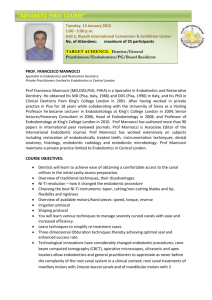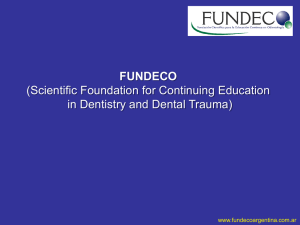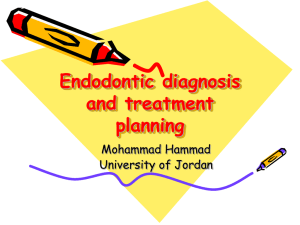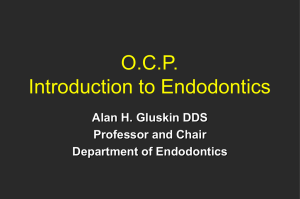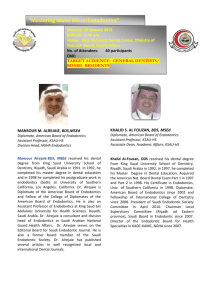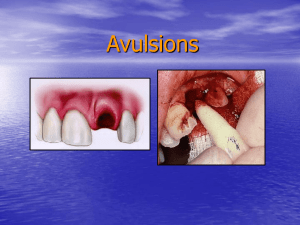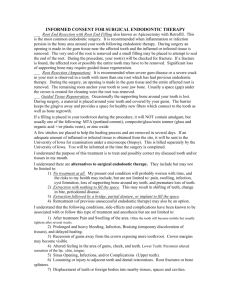For more information about the course
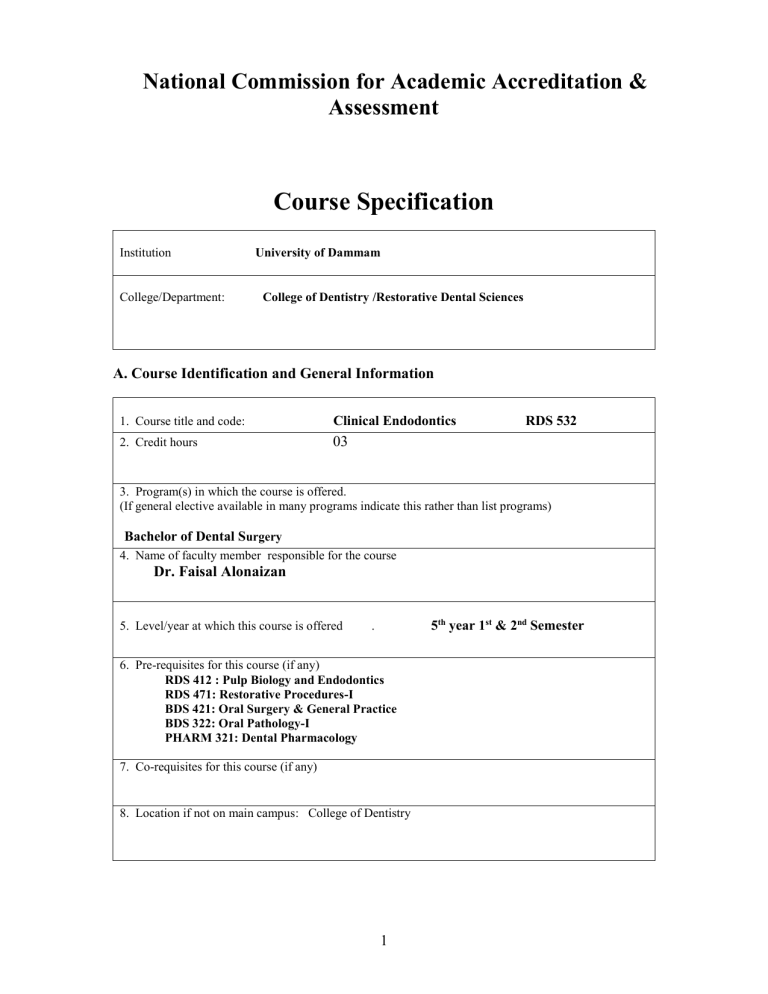
National Commission for Academic Accreditation &
Assessment
Course Specification
Institution University of Dammam
College/Department: College of Dentistry /Restorative Dental Sciences
A. Course Identification and General Information
1. Course title and code: Clinical Endodontics RDS 532
2. Credit hours 03
3. Program(s) in which the course is offered.
(If general elective available in many programs indicate this rather than list programs)
Bachelor of Dental S urgery
4. Name of faculty member responsible for the course
Dr. Faisal Alonaizan
5. Level/year at which this course is offered . 5 th year 1 st & 2 nd Semester
6. Pre-requisites for this course (if any)
RDS 412 : Pulp Biology and Endodontics
RDS 471: Restorative Procedures-I
BDS 421: Oral Surgery & General Practice
BDS 322: Oral Pathology-I
PHARM 321: Dental Pharmacology
7. Co-requisites for this course (if any)
8. Location if not on main campus: College of Dentistry
1
B. Objectives
1. Summary of the main learning outcomes for students enrolled in the course.
The overall goal of this course is to deliver the knowledge and skills required to successfully perform endodontic therapy in general practice. Dental students will be exposed to a variety of common endodontic case types, which may include endodontic emergency cases as well as traumatic injuries if there are available. The clinical skills are continuation of the technical skills introduced in RDS 412 with emphasis in increasing clinical proficiency under faculty supervision. In addition, students will be able to recognize the degree of complexity in endodontic cases and subsequently, communicate with faculty members and endodontic residents.
2. Briefly describe any plans for developing and improving the course that are being implemented. (eg increased use of IT or web based reference material, changes in content as a result of new research in the field):
Introduction of Case presentations where in the students are expected to present their cases at the end of each semester. The presentation of cases in each semester will be considered as one of the components of continuous assessment.
Students will perform endodontic therapy using rotary instruments as a requirement.
Self-evaluation has been introduced where student will evaluate his own work before an instructor can evaluate him.
C. Course Description (Note: General description in the form to be used for the Bulletin or
Handbook should be attached)
1 Topics to be Covered (First Semester)
List of Topics
No of
Weeks
Contact hours
Lectures and clinics.
Introduction/Biomechanical Basis for Endodontic Instrumentation and Obturation
Techniques.
1 4
2
Clinical Diagnostic Procedures
Vital Pulp Therapy
Endodontic Pain and Emergency
Endodontic Mishaps
Periodontal –Endodontic Interrelationship
Restoration of Root Canal Treated Teeth
Dental Traumatic Injuries
Rotary Files in Endodontics
Endodontic Retreatment
Endodontic Surgery
Evaluation of Endodontic Treatment Outcomes and the Role of Modern
Technologies in Endodontics
Bleaching of Discoloured Teeth
1
1
1
1
1
1
1
1
1
1
1
1
Tooth Resorption
Only Clinical Sessions in Second Semester
2 Course components (total contact hours first semester):
Lecture: 14 Tutorial: Laboratory
1 4
No of
Weeks
Contact hours clinics.
15 45
Practical/Field work/Internship:
45
Other: Exams (1 & 2)
2
4
4
4
4
4
4
4
4
4
4
4
4
3
Course components (total contact hours second semester):
45
3. Additional private study/learning hours expected for students per week. (This should be an average :for the semester not a specific requirement in each week)
4. Development of Learning Outcomes in Domains of Learning
For each of the domains of learning shown below indicate:
A brief summary of the knowledge or skill the course is intended to develop;
A description of the teaching strategies to be used in the course to develop that knowledge or skill;
The methods of student assessment to be used in the course to evaluate learning outcomes in the domain concerned. a. Knowledge
(i) Description of the knowledge to be acquired
I.2. Describe dental materials’ structures, properties and manipulative variables.
1.
List the required properties of root-end filling material.
2.
Describe bleaching agents and their possible adverse effects on dental structures.
3.
Describe different techniques for bleaching of endodontically treated teeth and their indications
& contraindications.
I.17. Discuss the complications of dento-alveolar surgery.
1.
List indications for surgical endodontics and its role in treatment planning and their preoperative assessment process.
2.
List key instruments used in different endodontic surgeries.
3.
List the principles and rationales for flap design and suturing selection in surgical endodontics.
4.
List the post-operative instructions and discuss the importance of follow-up examination
I.22. Describe the various theories, concepts, techniques and principles of operative dentistry and endodontics.
1.
Discuss different rotary instruments and terminology used in endodontics.
4
2.
Describe their properties, limitations, advantages and disadvantages.
3.
Recognize the importance of sterilization of endodontic instruments, various methods and effects on efficiency and physical properties of instruments.
4.
Recognize the importance of magnification in modern endodontics
5.
List the main advantages and disadvantages of NiTi and Stainless Steel instruments
6.
Describe the materials and techniques used for retreatment
7.
Discuss the recent advances in regenerative endodontics and recognize its impact on the vital pulp therapy.
8.
Describe techniques for restoring an access opening.
I.24. Discuss a range of treatment options in endodontics related to lesions affecting pulp and periapical tissues.
1.
List the classification of endodontic-periodontal diseases and their differential diagnosis
2.
List the etiologic factors associated with endodontic-periodontal diseases
3.
Classify tooth resorption
4.
Explain the differences between internal and external dental resorption
I.31. Describe the criteria for success and failure of restorative and endodontic procedures.
1.
Explain criteria of successful endodontic therapy.
2.
Discuss reasons for root canal treatment failure.
3.
State the outcomes of root canal treatment based on pretreatment conditions.
4.
State the outcomes of retreatment, endodontic surgeries and other alternative treatment.
5.
Explain the post-retreatment complications, restorative options, follow-up care of endodontically treated teeth.
6.
List prognosis of endodontic surgeries and influencing factors.
7.
Discuss the types of pulpal irritants and their relative importance in maintaining the pulp vitality during dental procedures.
8.
Discuss the factors affecting the prognosis of different vital pulp treatments, their indications and contraindications
I.32. Discuss the complications of endodontic therapy.
1.
List causes for Endodontic Mishaps.
2.
Discuss causes for endodontic emergencies and their treatment protocols.
(ii) Teaching strategies to be used to develop that knowledge
Lectures
5
(iii) Methods of assessment of knowledge acquired
1- MCQs
2- True/False
3- Short answer questions. b. Cognitive Skills
(i) Description of cognitive skills to be developed
II.3. Analyse and interpret data collected from the patient’s history, clinical, radiographic and other investigations.
1.
Interpret radiographic findings of patients indicated for endodontic therapy.
2.
Appraise the use of radiographs during endodontic procedures.
3.
Select appropriate radiographic technique for endodontic therapy.
4.
Analyse the causes of errors in radiographs taken during endodontic therapy.
II.4. Choose the appropriate diagnostic and management techniques based on patient age, behaviour capabilities, stage of dental growth/development, and chief complaints.
1.
Select appropriate diagnostic tests and aids used in endodontics.
2.
Differentiate between normal and abnormal responses of pulp to diagnostic tests.
II.5. Formulate differential diagnoses and reach definite diagnosis of oral hard and soft tissue lesions.
1.
Differentiate between pain of pulpal and non-pulpal origin.
2.
Differentiate between acute and chronic periapical conditions.
3.
Differentiate between Pulpal and periradicular diseases.
II.6. Formulate a comprehensive, sequential dental treatment plan based on the diagnostic findings for the child, adolescent and adult patient.
1.
Formulate/select a treatment plan based on history, examination, diagnosis and differential diagnosis in endodontics.
2.
Formulate an appropriate treatment plan for alleviating pain in endodontic emergencies.
II.15. Appraise challenges, failures and emergency cases in endodontics, prosthodontics and restorative dentistry.
1.
Identify endodontic problems that require treatment modifications.
6
2.
Identify retreatment options in endodontics.
II.16. Choose techniques, materials and instruments for individual cases indicated for prosthodontics, restorative and endodontic treatment.
1.
Select appropriate treatment protocol for vital pulp therapy.
2.
Select various materials and instruments used in endodontics.
3.
Choose amongst various treatment modalities for treating root canals with open apices.
4.
Recognize the factors affecting the delivery of endodontic therapy.
5.
Compare between various irrigation solutions used in endodontic therapy.
6.
Compare between various intracanal medicaments used in endodontic therapy.
7.
Compare between various obturation materials.
8.
Recognize indications for supplemental anesthesia in endodontics.
II.22. Establish prognosis of endodonticaly involved teeth.
1.
Predict the short- and long-term prognosis of treatment and influencing factors
2.
Predict outcomes of non-surgical endodontic therapy based on pretreatment conditions.
3.
Establish prognosis of cases undergoing retreatment and/or endodontic surgery.
(ii) Teaching strategies to be used to develop these cognitive skills
1.
Lectures
2.
Clinical case presentations
3.
Demonstrations
4.
Discussions
(iii) Methods of assessment of students cognitive skills
Clinical case presentations and students will be asked to:
1.
Interpret the radiographs
2.
Formulate differential diagnosis
3.
Formulate an appropriate treatment plan c. Interpersonal Skills and Responsibility
(i) Description of the interpersonal skills and capacity to carry responsibility to be developed
(ii) Teaching strategies to be used to develop these skills and abilities
(iii) Methods of assessment of students interpersonal skills and capacity to carry responsibility
7
d. Communication, Information Technology and Numerical Skills
(i) Description of the skills to be developed in this domain.
(ii) Teaching strategies to be used to develop these skills
(iii) Methods of assessment of students numerical and communication skills e. Psychomotor Skills (if applicable)
(i) Description of the psychomotor skills to be developed and the level of performance required
III.2. Perform and order the special investigations needed for diagnosing patients’ chief complaint including oral and maxillofacial radiographic imaging.
1.
Perform various diagnostic tests for pulpal and periapical responses.
III.5. Perform various techniques of local anaesthesia and manage their complications.
1.
Administer supplemental anaesthesia to control pain during endodontic therapy.
III.7. Perform isolation of the operative and endodontic fields.
1.
Apply rubber dam isolation during non-surgical endodontic therapy.
III.9. Perform conservative esthetic restorative procedures.
1.
Perform non-vital bleaching for root canal treated teeth.
III.11. Manage failures and emergencies in restored and endodontically treated teeth.
1.
Manage endodontic cases of traumatic injuries, reimplantation and splinting of teeth.
2.
Perform various modalities of vital pulp therapy including apexogenesis and apexification.
III.18. Perform non-surgical root canal treatment using different available techniques.
1.
Prepare different outlines of access cavities according to tooth morphology.
2.
Locate root canals according to tooth morphology.
3.
Determine working length in endodontic therapy using radiographs and electronic instruments.
4.
Perform cleaning and shaping of canals using hand and rotary instruments.
5.
Employ various radiographic techniques during endodontic therapy.
6.
Perform root canal obturation using lateral compaction technique.
7.
Retreat defective and failed root canal therapy.
8.
Manage various mishaps/complications that may occur during endodontic procedures
8
(ii) Teaching strategies to be used to develop these skills
1.
Regular supervision in every step of the Clinical procedures
2.
Giving clinical tips in overcoming difficulties in certain complex cases
(iii) Methods of assessment of students psychomotor skills
1.
Continuous assessment of clinical cases completed by the student as part of requirements.
2.
Practical examinations include two clinical cases treated by the student.
5. Schedule of Assessment Tasks for Students During the Semester
Assess ment
Assessment task (eg. essay, test, group project, examination etc.)
Week due Proportion of Final
Assessment
1
2
3
1
2 st nd
Midterm written examination
Midterm written examination
Practical examination
7 th
12
14 th th
10%
10%
20%
4
Case presentation 15 th 10%
5
Submission of logbooks for evaluation 15 th 30%
6 Final written examination
Midterm Exams and Final Written Exam:
The details of the exams will be given to the students at least two weeks prior to the commencement of the exam. The choice of questions i.e MCQ’s / Short Notes is at the discretion of the Course Director and the Faculty taking the lectures.
Clinical Requirements:
Each student is expected to complete 10 clinical cases (RCTs) by the end of the year.
Number of cases to be completed during first semester:
• Two Single-canal teeth
•
•
Two Maxillary Premolars with two canals
One Maxillary/Mandibular Molar
Number of cases to be completed during the second semester:
• Two Maxillary Premolars with two canals.
•
Three Maxillary/Mandibular Molars
Finishing the clinical requirements is mandatory for passing this course.
*Student Case Presentation Evaluation Form
Student Name Presentation Skills
[10]
Content
[10]
15 th 20%
Response to
Questions
[10]
9
Criteria for evaluation:
Presentation Skills
Clarity of voice &Confidence
Interaction with audience
Effective use of visual aids
Structure and organization
Content Information (relevant)
Preparation
Student Case Presentation
Each student has to present any 3 cases, out of the 10 cases he has completed during the course. First case presentation will take place towards the end of First Semester where all students will present one of their completed cases.
Second case presentation will take place towards the end of Second Semester where student will present two of their completed cases. Cases should include one maxillary premolar with two canals and one maxillary/mandibular molar and must include hand and rotary instrumentation.
The presentation should follow the following sequence
1. Chief complaint
2. Brief History [Medical, Dental & history of present condition]
3. Radiographs
4. Vitality tests
5. Diagnosis
6. Instrumentation techniques used, irrigation methods, intracanal medicaments [if any used]
7. Comments on the final obturation
8. Prognosis of your treatment
If the student has encountered any mishaps/accidents, procedural errors, he should be prepared with the reasons for the problem, methods with which he could avoid these mistakes, steps he has taken to overcome these problems and the effect of the mistakes on the prognosis of the restorability / longevity of the tooth.
Students should present all the radiographs and clinical pictures if in case of an abscess or sinus
[including the radiograph for tracing the sinus]
Each student will be allocated no more than 8 mins for each presentation.
D. Student Support
1. Arrangements for availability of teaching staff for individual student consultations and academic advice.
(include amount of time teaching staff are expected to be available each week)
Students were encouraged to ask anything they didn’t understand during Clinical sessions / lectures. Each staff member involved in the course had dedicated office hours (4 hours/ week) during which students can consult him.
E. Learning Resources
1. Required Text(s)
1.
Endodontics: Principles and Practice. Mahmoud Torabinejad, Richard E. Walton 4th Edition.
Elsevier Health Sciences, 2009.
2. Essential References
1.
Pathways of the pulp. Kenneth M. Hargreaves, Stephen Cohen . 10th Edition. Mosby Elsevier.
2.
Ingle's endodontics 6. John Ide Ingle. 6th Edition. PMPH-USA, 2008.
3.
Clinical Endodontic Manual.
10
3- Recommended Books and Reference Material (Journals, Reports, etc) (Attach List)
4-.Electronic Materials, Web Sites etc
1.
Electronic resource such as peer review journals (Journal of Endodontics International
Endodontic Journal).
5- Other learning material such as computer-based programs/CD, professional standards/regulations.
F. Facilities Required
Indicate requirements for the course including size of classrooms and laboratories (ie number of seats in classrooms and laboratories, extent of computer access etc.).
1. Accommodation (Lecture rooms, laboratories, etc.)
1.
Lecture room with data show projector.
2.
Clinics with x-ray units/digital radiography.
2. Computing resources
.
1.
Computers in the Clinic floor.
2.
Computers to view radiographs.
3. Other resources (specify --eg. If specific laboratory equipment is required, list requirements or attach list)
1.
Endodontic Instrument Kits.
2.
Endodonitc Split Kits.
3.
Digital Radiographic units [RVG].
4.
Electric Pulp Testers.
5.
Endo Ice.
6.
Rotary Endodontic Machines.
7.
Rotary Endodontic Files.
G. Course Evaluation and Improvement Processes
1 Strategies for Obtaining Student Feedback on Effectiveness of Teaching
Course evaluation questionnaire (survey).
2 Other Strategies for Evaluation of Teaching by the Instructor or by the Department
3 Processes for Improvement of Teaching
1.
Staff development sessions.
2.
Orientation by department chairman or senior staff member.
3.
Group discussions amongst the faculty.
11
7
8
9
10
11
4. Processes for Verifying Standards of Student Achievement (eg. check marking by an independent member teaching staff of a sample of student work, periodic exchange and remarking of tests or a sample of assignments with staff at another institution)
1.
External course review is not available.
2.
Students have access to course director and other instructors to discuss their performance in any given assessment.
3.
Written examinations validity and questions difficulty levels are analyzed and discussed by course instructors.
4.
Multiple faculty members are involved in the evaluation of clinical procedures and case presentations performed by each student.
5. Describe the planning arrangements for periodically reviewing course effectiveness and planning for improvement.
1.
Identifying academically-challenged students as early as possible in order to provide necessary support and report them to academic advisor according to Academic Performance Policy.
2.
Departmental/specialty staff discussions to review students’ performance.
H. Lecture Schedule, Topics, and Assigned Presenters
Lecture
No.
Date
[Wednesday]
Topics
1 3-09-2014
Introduction/Biomechanical Basis for Endodontic
Instrumentation and Obturation Techniques
Lecturer
Dr. Alonaizan
2 10-09-2014 Endodontic Clinical Diagnostic Procedures Dr. AlShwaimi
3 17-09-2014 Vital Pulp Therapy Dr. Khabeer
5
6
4 24-09-2014
15-10-2014
Endodontic Pain and Emergency
Examination 1
22-10-2014 Endodontic Mishaps
Hajj Vacation
Dr. Mutasim
Dr. Khabeer
29-10-2014 Perio-Endo-Interrelationship
05-11-2014 Restoration of Root Canal Treated Teeth
12-11-2014 Traumatic Injuries
19-11-2014 Rotary Files in Endodontics
26-11-2014
Examination 2
Dr. Alonaizan
Dr. Majeed
Dr. Khabeer
Dr. Majeed
12
12 03-12-2014 Endodontic Retreatment Dr. AlShwaimi
13
14
10-12-2014 Endodontic Surgery
17-12-2014
Evaluation of Endodontic Treatment Outcome and the Role of Modern Technologies in
Endodontics
24-12-2015 Bleaching of Discoloured Teeth
Dr. Alonaizan
Dr. Mutasim
15 Dr. Majeed
16 31-12-2014 Tooth Resorption Dr. Mutasim
17 TBD
Final Examination
I. Lecture Objectives
After didactic sessions the students are expected to be able to:
LECTURE 1: BIOMECHANICAL BASIS FOR ENDODONTIC
INSTRUMENTATION AND OBTURATION TECHNIQUES a) Discuss the primary objectives in cleaning and shaping the root canal system. b) Identify the most common traditional and modern instrumentation and obturation technique. c) Identify the common technical and biological challenges during performing an endodontic treatment. d) Contrast between the instrumentation (and obturation) techniques used in this course and commonly used techniques.
LECTURE 2: ENDODONTIC CLINICAL DIAGNOSTIC PROCEDURES a) Recognize the role and importance of diagnosis in endodontics. b) Recognize that diagnosis of pulpal and periradicular conditions as part of a broader examination and treatment plan. c) Identify and explain the importance of medical and dental history and findings to endodontic diagnosis.
13
d) Communicate effectively with patients and ask the right questions regarding the history and symptoms of the present complaint. e) Conduct extra- and intra-oral examination. f) Apply and interpret pulpal responses to different testing methods and document them in data collection sheet. g) Identify limitation of vitality tests. h) Interpret radiographic findings and synthesis them with other diagnostic information to enable appropriate differential diagnosis. i) Identify the endodontic emergencies and integrate their treatment into treatment plan j) Identify problems that require treatment modifications (periodontal problems, abnormal root canal system anatomy, restricted mouth opening, isolation difficulties, restorability). k) Identify modern diagnostic tools in endodontics.
LECTURE 3: VITAL PULP THERAPY a) Describe the cellular components involved in the healing process of the pulp. b) Describe the different types of pulpal irritants and their relative clinical significance. c) Explain the response of pulp tissues to common biological, chemical, and thermal irritants. d) List precautions necessary to maintain pulp vitality during dental procedures. e) List clinical factors affecting prognosis of different vital pulp treatment. f) Explain different types of vital pulp therapy procedures and their indications/contraindications. (Direct pulp capping, Pulpotomy, Open Apex
Apexogenesis, Apexification, Tissue Regeneration). g) Recognize the impact of modern regenerative endodontic advances on vital pulp therapy procedures.
LECTURE 4: ENDODONTIC PAIN AND EMERGENCY a) Describe the anatomical and functional aspect of dental pulp nerve tissues. b) Identify the classification of nerve fibers.
14
c) Discuss the approach toward establishing differential diagnoses of endodontic and orofacial pain, and that of non-endodontic in origin. d) Explain the mechanism of pulpal pain. e) List the common pulpal and periapical endodontic emergencies. And describe their clinical and/or pharmacological management. f) Recognize the differences between emergency and urgency. g) Define endodontic flare-up. h) Identify patients who are greater risk for experiencing pain after endodontic procedures. i) Describe the systematical approach to emergency conditions [establish diagnosis and etiologic factors, design emergency treatment plan and then long-term treatment plan]. j) Explain post-emergency endodontic assessment.
LECTURE 5: ENDODONTIC MISHAPS a) Identify the complexity and difficulty of specific cases that may lead to procedural accidents. b) Identify the differences between treatment complications and procedure errors. c) Recognize the following procedural accidents:
Anesthesia accidents. Such as needle fracture, intravascular injection.
Access-related-mishaps. Such as furcal perforation.
Instrumentation mishaps. Such as canal blockage, ledges, instruments fracture, zipping, canal transportation and root canal perforation).
Root canal filling mishaps. Such as overfilling, over extension, under filling, and sealer extrusion.
Irrigant-related mishaps. Such as Sodium hypochlorite accident, allergies, and spills.
Vertical root fracture.
Restorative procedures mishaps. d) List the causes, prevention and management of endodontic mishaps.
15
e) Describe the impact of mishaps on the prognosis of root canal treatment. f) Recognize the importance of consultation and identify cases that need referral.
LECTURE 6: PERIODONTAL AND ENDODONTIC INTERRELATIONSHIP a) Recognize the anatomic communication between the dental pulp and the periodontal tissues. b) Describe the effect of dental pulp diseases and root canal treatment procedures on the periodontium. c) Describe the effect of periodontal diseases and therapeutic procedures on the dental pulp. d) List and explain the etiologic factors associated with endodontic-periodontal diseases. e) Identify the classification of endodontic-periodontal diseases and their differential diagnosis. f) Discuss treatment plan sequence, requirements and predict prognosis of endoperio diseases.
LECTURE 7: TRAUMATIC INJURIES a) Describe (clinical and radiographic features) the World Health Organization classification of dental traumatic injuries (Enamel fractures, Crown fracture with and without pulp involvement, Crown-root fracture, Root fracture, Tooth avulsion, Tooth luxation, Extrusion and Intrusion, Alveolar fracture). b) List possible short and long-term responses of dental pulp, dental hard tissues, and periradicular tissues to the various traumatic injuries c) List patient information needed during examination of injuries (health history, nature of injury, and symptoms) and necessary diagnostic tests/ procedures. d) Describe appropriate short and long-term treatment strategies for type of injuries. e) Recognize outcomes of traumatic injuries. f) Describe the differences in treatment strategies and management considerations for traumatic injuries in primary and permanent dentition. g) Describe the clinical steps of rigid and non-rigid splinting techniques.
16
LECTURE 8: RESTORATION OF ROOT CANAL TREATED TEETH a) Discuss effect of root canal treatment on teeth and the importance of remaining hard dental tissues. b) Describe the main predictors for survival of endodontically treated teeth. c) Explain the impact of the coronal seal on long-term success and how to achieve it. d) Outline postoperative risks for the non-restored endodontically treated tooth. e) Discuss timing of the restoration, temporary restoration and the rational for immediate permanent restoration. f) Identify the importance of identification of restorative options before commencing root canal treatment. g) Discuss advantages and disadvantages of different restorations. h) List common intra-canal post and systems. i) List commonly used core materials. j) Explain the importance of the ferrule for the success of extracoronal restoration. k) Describe techniques for restoring an access opening.
LECTURE 9: ROTARY FILES ENDODONTICS a) Discuss the advantages and disadvantages of NiTi endodontic files. b) Identify the nomenclatures encountered in rotary instrument designs. Such as flute, radial land, rake angle, maximum flute diameter, torque, and reciprocation. c) List different types of commonly used rotary file systems. d) Explain the important clinical steps considered during Cleaning and shaping methods using rotary instruments. e) Identify single file systems.
LECTURE 10: ENDODONTIC RETREATMENT a) List and discuss the possible reasons for root canal treatment failure. b) List the indications and contraindications for root canal retreatment.
17
c) Identify the root canal retreatment options and cases that need referral to a specialist. d) Explain the benefits and risks of root canal retreatment options with the patient. e) Describe the materials and techniques available for root canal retreatment. f) Explain the potential complications, restorative options, follow-up care and the prognosis of root canal retreatment.
LECTURE 11: ENDODONTIC SURGERY a) List the indications and contra-indications for surgical endodontics. b) Explain the role of endodontic surgical procedure in the treatment plan. c) Describe the pre-operative assessment process. d) Describe the common surgical endodontic procedures. Such as incision for drainage, apical curettage, root-end resection, root-end preparation and filling, root amputation, hemisection, bicuspidization and Intentional replantation. e) List the main steps involved in endodontic surgeries. f) Identify key instruments used in different endodontic surgeries. g) List the principles and rationales for flap design and suturing selection. h) List and explain the required properties of root-end filling material i) List the post-operative instructions and discuss the importance of follow-up examination. j) List regenerative procedures and recognize their impact on endodontic surgeries. k) List prognosis of endodontics surgeries and influencing factors. l) Recognize conditions for referral.
LECTURE 12: EVALUATION OF ENDODONTIC TREATMENT
OUTCOME AND
THE ROLE OF MODERN TECHNOLOGIES IN
ENDODONTICS a) List and explain criteria of successful treatment b) Explain difference among successful, uncertain and failed root canal treatment.
18
c) Describe the outcome of root canal treatment based on pretreatment conditions. d) Describe the outcomes of retreatment, endodontic surgeries as well as alternative treatment (fixed prosthesis and implants). e) Identify the potential causes for endodontic therapy failure. f) Recognize the role of utrasonics in modern conventional and surgical endodontics. g) Describe the different modern techniques, methods, devices for root canal obturation. h) List the new root canal filling materials, main advantages and limitations. i) Recognize the importance of magnification in modern endodontics.
LECTURE 13: BLEACHING OF DISCOLORED TEETH a) List and explain the reasons and nature of tooth discoloration in endodontically treated teeth. b) Describe means of preventing coronal discoloration. c) Differentiate between dentine and enamel discoloration. d) Describe bleaching agents and treatment techniques according to the cause of discoloration, their possible adverse effects on dental structures. e) Identify the short- and long-term prognosis of bleaching and influencing factors. f) Describe the different techniques used for bleaching endodontically treated teeth, their indications and contraindications. g) Describe restorative procedures and materials to restore bleached teeth.
LECTURE 14: TOOTH RESORPTION a) Explain the biological mechanism of tooth resorption. b) Recognize the classification of root resorption. c) Explain the differences between internal and external dental resorption. d) List the potential etiological factors for root resorption. e) Describe methods and tests for diagnosis of each type of root resorption. f) Prepare treatment plan according to resorption type and patient needs. g) Predict the short- and long-term prognosis of treatment and influencing factors.
19
20
